German Shepherd Facts
A resource guide for the new or experienced owners of the German Shepherd Dog
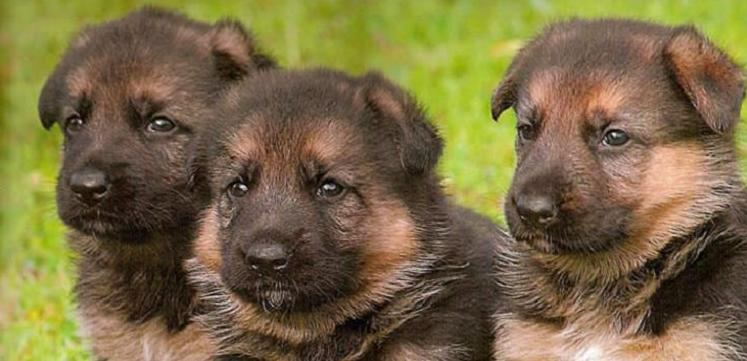

German Shepherd Dog History
“If any breed of dog is most deserving of the title Noble with Natural Beauty then that dog is the German Shepherd”
No one breed of dog is for everyone, but there is one breed that could be for just about anyone. It’s known for its beauty and its brains; its strength and its gentleness. It’s a helper to the disabled, a guardian of homes, a companion to children, a protector of livestock, and a partner in crime-fighting. There is little this dog cannot do, and almost nothing it’s not willing to try. It’s the multi-purpose, multi-tasking, ever-popular, hard-working German Shepherd Dog.
Great Stock Dogs
The development of today’s German Shepherd Dog, or GSD, began in 1899 when Rittmeister von Stephanitz discovered Hektor, a sheep-herding dog who seemed to be an outstanding example of the ancient herding breeds native to northern Germany. Renamed Horand von Grafrath, the dog became the first dog to be officially registered with the newly-formed Verein fur Deutsche Schaferhunde, the German Shepherd Dog Club of Germany, and was the foundation for all GSDs to follow. GSDs came to America soon after and were recognized by the American Kennel Club in 1911.
GSDs have many qualities that make them well-suited to working with livestock: physical and mental endurance, agility, alertness, courage, and a great willingness to serve. GSDs still work on farms and ranches throughout the world, but these abilities, and others, make them prime candidates for other canine “jobs,” which they perform with equal dedication and skill.
Genuine Schutzhund Dogs
The innate talents and abilities of the German Shepherd Dogs are brought out in impressive form through Schutzhund training. “Schutzhund” is a German word meaning “protection dog.” Schutzhund-trained dogs are not attack dogs; they are trained to ward off dangerous situations, not provoke them. The most important quality of a Schutzhund dog is complete submission to its owner’s commands in any situation.
Schutzhund training has three parts: Tracking, Obedience, and Protection.
- The Tracking portion tests a dog’s trainability, ability to follow a scent, and mental and physical endurance.
- In the Obedience portion, dogs perform a variety of exercises such as heeling, sitting, retrieving, and remaining steady during distractions.
- The Protection portion tests the dog’s courage, strength, and agility by requiring the dog to find a hidden person and defend its owner against a decoy aggressor.
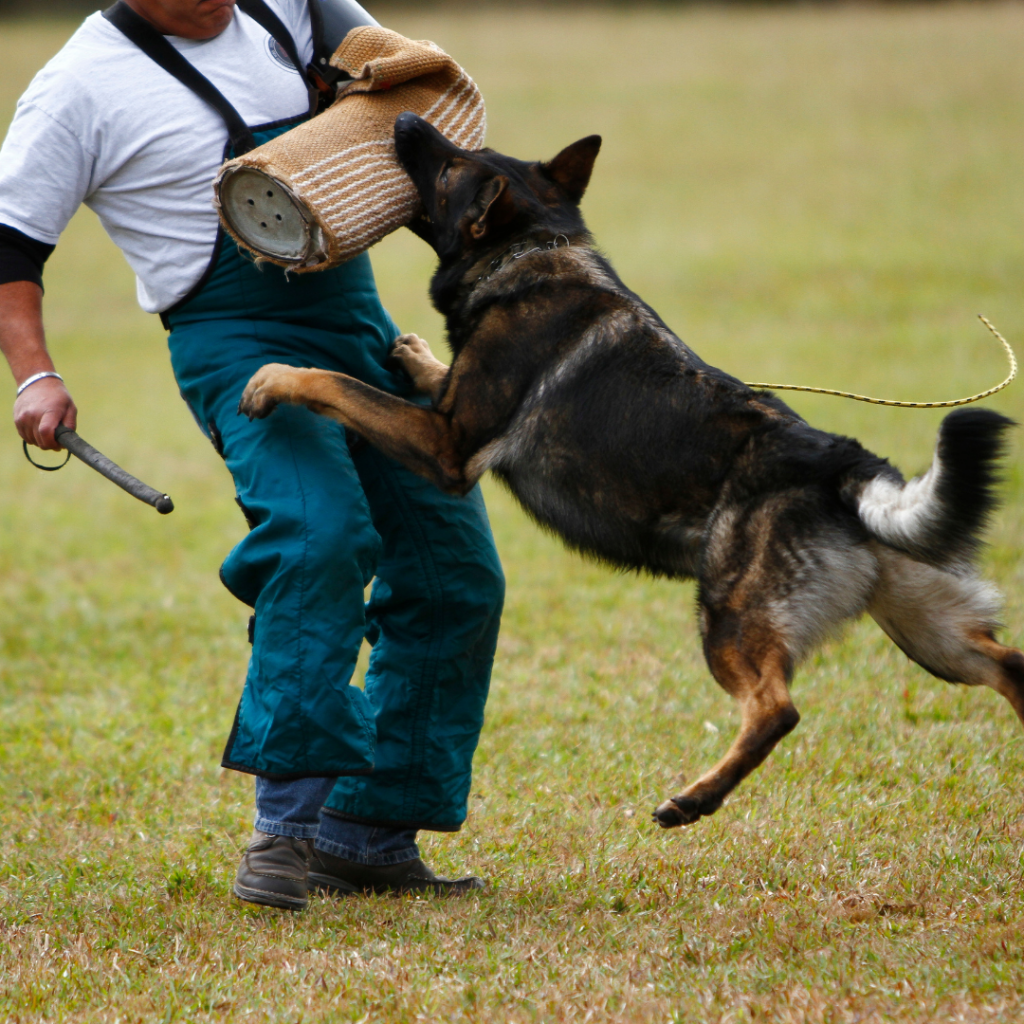
Schutzhund training and trials take place around the world. In some countries, proven working abilities are required for GSDs to attain their championships. Schutzhund dogs are excellent candidates for canine law enforcement and search and rescue work. Although Schutzhund training is for all breeds, GSDs particularly excel due to their intelligence, their bravery, and their desire to please their masters.
Gentle Service Dogs
After World War I, a kennel in Pottsdam, Germany, began a program to train German Shepherd Dogs to assist veterans blinded in combat. The program was short-lived, but an American living in Switzerland, Dorothy Harrison Eustis, adopted the idea and began her own training program. Soon after, Buddy, a female German Shepherd Dog, became the first Seeing Eye dog in America. She was the help meet and companion of Morris Frank, who then established a guide dog school in Nashville, Tennessee, in 1929. Since that day, GSDs have been the “eyes” for thousands of people around the world.
The success of the guide dog program led to the training of GSDs–and other breeds–as service dogs for people with hearing impairment and other physical disabilities. The German Shepherd Dog is an ideal service dog due to its ready obedience to commands, its ability to ignore distractions, its protective instincts, and its unwavering loyalty to its owner.
Gifted Security Dogs
German Shepherd Dogs have a long history of working with law enforcement officers. Their tasks are numerous: accompanying officers on patrol (and thereby deterring crime), pursuing criminals, recovering evidence, and detecting drugs, explosives, and other contraband. GSDs also serve as Search and Rescue dogs and have been commended for their work in recovering victims of natural disasters such as hurricanes and earthquakes, and of national tragedies such as the Oklahoma City bombing and the terrorist attacks of September 11, 2001.
Dogs working in law enforcement have to have excellent noses and physical stamina; they have to respond quickly to their handler’s orders while still using their own judgment. They must be relied upon to perform their duties without displaying aggression to children, other officers, or innocent persons in crowds. More importantly, they must possess the “heart” to consistently follow commands day after day, often in difficult, demanding environments. The GSD’s innate courage and mental acumen make him eminently capable of this type of work.
Gorgeous Show Dogs
Although developed as a working dog, the German Shepherd Dog is lovely to look at. Some of its notable physical characteristics are its erect ears, its deep, dark eyes, its long saber tail (meaning that it hangs in a slight curve), and its rich color, most often black and tan, sable, or black. A quality GSD should be strong, agile, and well-muscled, and should appear to “glide” when in motion, as though its feet barely touch the ground.
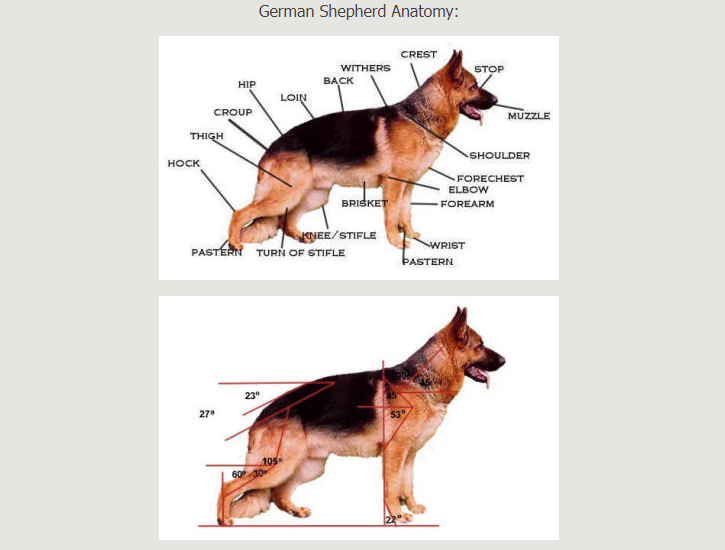
The German Shepherd is essentially a trotting dog. Developed for herding the dog would work all day – almost always in a trot never tiring. Therefore strict adherence to the structural makeup is of utmost importance. Croup formation and shoulder angulation are just many of the features that seriously dedicated breeders work for in their breeding stock.
With sound structural efficiencies for long, arduous work, the standard for the German Shepherd Dog calls for mental stability and a willingness to work. The dog should be approachable, quietly standing its ground, showing confidence and a willingness to meet overtures without itself necessarily making them. It should be generally calm, but eager and alert when the situation warrants it. It should be fearless, but also good with children.
The German Shepherd Dog should not be timid or react nervously to unusual sounds or sights. A dog that is overly aggressive because of its overall fears of people and events can be extremely dangerous. These dogs should be eliminated from the gene pool as dogs that are not structurally sound.
GERMAN SHEPHERD: Originally a herding dog, it seems the German Shepherd can be trained to do any job. Police, search and rescue, military, assistance, Guide work – it thrives on a life of service.
Standardized in Germany in the 1890s
German Shepherds were bred for Herding
German Shepherds are in the AKC Herding Group
Fearless, devoted, intelligent
Daily brushing
Regular, vigorous
Adapts well to urban living
Outstanding watchdog
Life expectancy is around 13 years
Males: 24-27 inches 85-100 pounds
Females: 22-25 inches 55-75 pounds
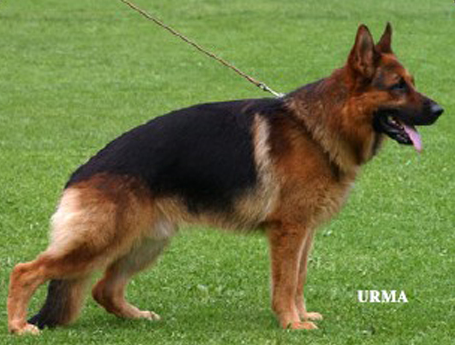
Interested In Understanding German Titles & Ratings on Pedigrees? We Have Resources for You!
USA/SV German Shepherd Breed Standard
Introduction:
The United Schutzhund Clubs of America Inc. is a German Shepherd Dog Breed Organization guided by the rules of the organization of origin of the German Shepherd Dog, the “Verein für Deutsche Schäferhunde (SV)” in Germany, and is strongly devoted to creating and promote the German Shepherd Dog in its original breeding as a working dog. The United Schutzhund Clubs of America Inc. is a member of the “World Union of German Shepherd Dog Clubs” and accepts the by-laws of this organization in regards to the breeding rules of German Shepherd Dogs.
The following translation of the German Shepherd Dog F.C.I. Standard, MO. 166/23.03.1991/D translated from the SV publication 1998 has been submitted by Johannes Grewe and is recommended by the 1998 Breed Advisory Committee for approval by the Executive Board at their meeting in 1998.
The “Standard” is part of the USA By-laws.
The Executive Board approved the following ” Standard ” at the meeting in Bangor, Maine, on May 6, 1998.
Short Historical Overview
In accordance with the official provisions of the German Shepherd Dog Club (SV) e.V., located in Augsburg, a member of the Federation of Dog Clubs in Germany (VDH) is the founding organization of the German Shepherd Dog and therefore, responsible for the breed standard. Work on this document was begun at the first membership meeting in Frankfurt/M on September 20, 1899, and is based on proposals by A. Meyer and v. Stephanitz. Additions and revisions to the standard were made as follows: membership meeting on July 28, 1901; 23rd membership meeting on September 17, 1909, in Koln; Board and Executive Committee Meeting on September 5, 1930, in Wiesbaden, and the Breeders Committee and Board Meeting on March 25, 1961, in conjunction with the WUSV (World Union of German Shepherd Clubs) and during the WUSV Meeting on August 30, 1976, where the standard was agreed upon, revised, and approved by the Board and Executive Committee on March 23 and 24, 1991.
Planned breeding activities began after the inception of the SV in 1899. The German Shepherd Dog was developed from herding dogs in service during that time in Middle and Southern Germany. The goal was to produce a high-performance working dog. To accomplish this goal, the Breed Standard of the German Shepherd Dog was created. This document addresses both physical qualities as well as character attributes.
General Appearance
The German Shepherd Dog is medium-sized, slightly longer than tall, strong, and well muscled, bone is dry, and the whole dog presents a picture of firmness.
Important Measurements
Height at the withers for males: 60 – 65 cm, bitches: 55 – 60 cm. Length of torso exceeds height at the withers by 10 – 17%.
Character
The German Shepherd should appear poised, calm, self-confident, absolutely at ease, and (except when agitated) good-natured, but also attentive and willing to serve. He must have courage, fighting drive, and hardness in order to serve as a companion, watchdog, protection dog, service dog, and herding dog.
Head
The head is wedge-shaped and in harmony with the dog’s size (length app. 40% of height at the withers) without being coarse or overly long. The head should appear dry, and moderately wide between the ears. Seen from the front and side, the forehead is only slightly domed, the center furrow is either absent or only slightly visible. The length ratio of skull to face is 50 : 50%. Skull width approximately equals skull length. Seen from above, the skull slopes into a wedge-shaped muzzle. The stop should not be pronounced. Upper and lower jaws are strong, the bridge of the nose should be straight, not a Roman nose or dish-faced nose. Lips are taut, well closed and of dark color.
The Nose
The nose should be black.
Teeth
The teeth must be strong and complete in number (42 teeth as per formula). The German Shepherd has a scissor bite, where the upper incisors must meet the lower incisors in a scissor grip. Level bite, overshot and undershot teeth are faulty, as well as widely spaced teeth. A straight incisor tooth line is also faulty. Jawbones must be well developed, to permit deep rooting of the teeth in the gum.
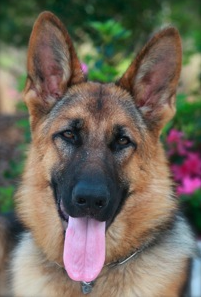
The Eyes
The eyes are medium-sized, almond-shaped, set slightly oblique, and not protruding. The color should be as dark as possible
Ears
The German Shepherd has medium-sized, upright ears which are carried erect and perpendicular to one another, pointed and open to the front. Tipped ears and hanging ears are faulty. Laid-back ears are not faulty when the dog is in motion or resting.
The Body
The top line extends from the point where the neck meets the skull past the well-developed withers and the gently downward sloping back to the slightly sloping croup without a visible break. The back is firm, strong, and well-muscled. The loin is broad, well-developed, and strongly muscled. The croup should be long and have a slight downward slope (approximately 23 degrees from horizontal) and should merge smoothly into the tail set.
Neck
The neck is strong, well-muscled, and clean cut (without folds of loose skin). The angle of the neck to the torso is approximately 45 degrees.
Chest
The chest should be of moderate width, the underchest long and pronounced. Chest depth should be approximately 45 to 48% of height at the withers. The ribs should be moderately sprung. Barrel shaped or flat ribs are faulty.
Tail
The tail reaches at least to the hock joint, but not past the halfway point of the hock itself. The coat is slightly longer on the underside of the tail. The tail hangs in a soft, saber-like curve. When the dog is excited or in motion, the tail is somewhat raised, but should not reach past the horizontal line. Surgical corrections are not permitted.
Limbs
Forelegs
Seen from all sides, the forelegs are straight and absolutely parallel when viewed from the front.
The shoulder and upper arms are of equal length. Both are held snugly to the body by strong muscles. Angulation of the shoulder blade to the upper arm ideally is 90 degrees, but up to 110 degrees is permissible.
Elbows may not turn out when the dog is standing or in motion or be pinched inward. The lower legs viewed from all sides are straight and absolutely parallel, dry, and well-muscled. The pastern measures about 1/3 of the forearm length and is angled 20-22 degrees to the foreleg. Pasterns with an angle of more than 22 degrees or very steep pasterns (less than 20 degrees) reduce working capability especially, endurance.
Paws
The paws are rounded, tight, and arched. The soles are hard, but not brittle. The nails are strong and dark.
Hind Legs
The rear legs have a pronounced rounded knee or turn of stifle which projects the dog’s rear quarter well behind the point of the pelvis. Seen from the rear, the hind legs are parallel to one another. The Upper and lower thighs are approximately the same length and form an angle of 120 degrees. Their thighs are strong and well muscled.
The hock joint is strong and dry and the hock stands upright under the joint.
Gait
The German Shepherd is a trotting dog. Length and angulation of front and rear legs must be in proper proportion to one another to permit the dog to move the rear leg underneath the body, matching the reach of the rear legs with that of the front legs and at the same time, keeping the topline over the back relatively undisturbed. Any tendency for over-angulation of the rear reduces firmness and endurance of the dog and therefore, working capability. Correct body proportions and angulation result in a ground-covering gait which moves close to the ground and conveys the impression of effortless movement. With the head held slightly forward and the tail slightly lifted, the dog trotting evenly and smoothly, we see a softly moving topline which flows without interruption from neck to tail tip.
Skin
The skin covers the body loosely, but without folds.
Coat
Coat Characteristics
The correct coat for the German Shepherd is a stock coat (outer and undercoat). The top coat should be as tight as possible, straight, coarse, and clinging closely to the undercoat. The head, including the inside of the ears, the front of the legs, the paws, and the toes have short hair. Neck hair is longer and thicker. On the rear side of the legs, hair length increases downward to the pastern and hock. The rear of the thighs is covered and shows moderate “pants”.
Pigment
Black with reddish brown, brown, tan to light-grey markings. Solid black, grey with darker overcast, black saddle, and mask. Inconspicuous small white chest markings, as well as lighter pigment on the inside of the legs, are permitted, but not desirable. All dogs, no matter what their color, must have black noses.
Missing masks, light to white markings on the chest and inner leg sides, light toenails, and a red tail tip are signs of faulty pigmentation. The undercoat has a slight grey cast. White is not permissible.
Size/Weight
Males: Height at the wither 60 cm to 65 cm
Weight 30 kg to 40 kg.
Females: Height at the wither 55 cm to 60 cm
Weight 22 kg – 32 kg
Testicles
Visual inspection must show two normally developed testicles fully descended into the scrotum.
Faults
Any deviations from the above-listed points are considered faults. Points deducted must be in accordance with the severity of the deviation.
Severe Faults
Deviations from the breed characteristics described above which compromise the working ability of the animal.
Ear Faults: ears set too low, tipped ears, overset ears, and soft ears.
Considerable lack of pigment.
Firmness strongly compromised.
Faults of Dentition:
All deviation from scissor bite and number of teeth, unless they are disqualifying faults.
Disqualifying Faults
a) Character weakness, nervous biters, and dogs with a weak nervous system;
b) Dogs with documented “severe hip dysplasia”;
c) Monorchids and cryptorchids as well as dogs with testicles of visibly uneven size or shrunken testicles;
d) Dogs with disfiguring ears and/or tails;
e) Malformed dogs;
f) Tooth faults as follows:
1. Missing 1 #3 premolar and one additional tooth;
2. Missing 1 canine tooth or
3. Missing 1 #4 premolar, or
4. Missing 1 molar #1 or #2 or
5. Missing a total number of 3 teeth and/or more;
g) Dogs with bite faults: overbite of 2 mm or more, or undershot; level bite;
h) Dogs that measure more than 1 cm over or under regulation size;
i) Albinism;j) White coat (incl. those with dark eyes and nails);
k) Long stock coat (long, soft loosely fitting outer coat with undercoat, flags on ears and legs, bushy pants, and bushy tail with a flag on the underside);
l) Long coat (long, soft outer coat without undercoat). This coat type frequently is parted along the center line of the back and has flags on the ears, legs, and tail.
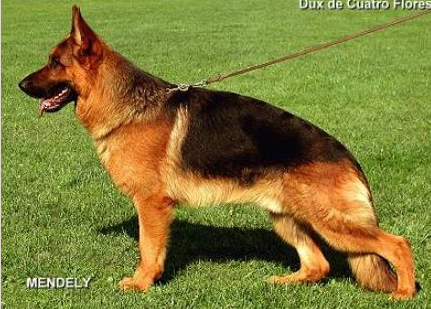
German Shepherds and the Breed Survey
Breed Survey
The breed survey is the ultimate instrument used as the selection method for the German Shepherd Dog Breed. It is absolutely necessary for the preservation and advancement of this breed.
Originally developed in Germany for their domestic stock, in 1922 the breed survey also became the tool used as a resource for breeding the German Shepherd Dog. Simply explained, German Shepherd Dogs need a certificate for reproduction.
This certificate is issued by the USA/SV organization which follows a special procedure where the breed survey judge evaluates the dog’s temperament in different stimulus situations. The dog must always demonstrate a friendly and self-confident character and in any situation, must show control even when in confrontation with its own natural instincts.
After these tests the dog will be measured, weighed, and anatomically analyzed in the stand position and also, when in movement. Based on each dog’s overall evaluation, it will be awarded the predicate Class I or Class II. Of course, not all dogs will be able to reach the level of these certificates.
The requirements to enter a dog in the breed survey event are not easy to achieve. They must be registered with the SV/USA organizations, absolutely healthy, a minimum of 2 years of age, they must have successfully completed an endurance test, received a rating of at least“good” in a breed show, they must have obtained at least a performance title of SchH 1 and must have certified hips. This may seem to be very restrictive, but it makes sense since we are looking for animals within our whole breed population, which have been selected based on their temperament, performance, and anatomy to improve and advance the breed.
This is an ideal tool for breeders to be able to carefully plan all their future breedings.
USA Breed Survey Regulations
1. GENERAL
The United Schutzhund Clubs of America (USA) is a German Shepherd Dog breed organization guided by the rules of the founding organization of German Shepherd Dogs, the Verein für Deutsche Schäferhunde (SV) in Germany, with the objective of preserving the breed in accordance with the breed standard as a working dog. The USA Breed Survey Regulations coincide with the SV regulations; however, they have been somewhat modified to conform to the needs of USA.
The USA Breed Survey Regulations govern all breed survey activities for the German Shepherd Dog. The purpose of the USA Breed Survey Regulations is to select breeding animals that, according to their temperament, performance, and anatomical characteristics, are suitable for maintaining and improving the breed.
2. USA SURVEY ORGANIZATION
2.1. Breed Book Office
The USA Breed Book Office checks all breed survey paperwork for correctness, then processes and files the reports. The USA Breed Book Office publishes a USA Breed Survey Book annually containing the data on all dogs that have been breed surveyed in a USA event.
2.2. Breed Survey Masters
USA appoints experienced USA breed judges to serve as breed survey masters and also uses SV Körmeisters. The breed survey masters have no legal claim to yearly breed survey assignments. Selection of breed survey masters lies with the local clubs.
2.3. Breed Survey Season
The season for breed surveys is from January 1st through December 31st of each year. Dogs may be presented for surveying one time during each season.
2.4. Breed Survey Entry Maximum
The number of dogs for each survey day is limited to 50. If more than 50 dogs are entered, an additional half-day must be added on the same weekend.
2.5. Legal
2.5.1. The decision of the breed survey master is final. Objections are not permitted.
2.5.2. Obtaining or losing breed survey status gives no legal claims to interested parties or outsiders. Any claims for damages from interested parties (owners) or outsiders arising from obtaining or losing breed survey status are denied.
2.5.3. The owner of the dog is liable for any damage caused by the dog.
3. PREREQUISITES FOR BREED SURVEY PARTICIPATION
3.1. USA Registration
Dogs must be registered with USA if the owner resides in the United States
3.2. USA Membership
Owners of the dogs must be current members of USA if residing in the United States. If the dog is co-owned, the signature-authorized owner must be a current USA member.
3.3. Age Requirement
Dogs must be a minimum of two years old in the year of the survey.
3.4. Performance Title
Dogs must have at least one performance title (SchH1-3, VPG1-3, IP1-3, or HGH) obtained under a USA-recognized performance judge, and a BH obtained under a WUSV-recognized judge. Dogs with an HGH title are not required to have a BH title.
3.5. Endurance Test
Dogs must have passed an endurance test (AD) under a USA-recognized judge; however, this requirement is waived for dogs with an HGH title and dogs that are six years and older.
3.6. Hip Certification
Dogs must have a USA-recognized hip certification with tattoo number or microchip identification. Note: Check with the USA Office for a current list of recognized hip certifications.
3.7. Breed Show Rating
Dogs must have a breed show rating of at least “good” obtained under a USA-recognized breed judge in the youth, young dog, or working dog class.
3.8. USA-Recognized Judges
The judges who are recognized by USA are USA judges, SV judges (including SV foreign judges), and Canadian judges.
3.9. Additional Prerequisites
3.9.1. Sick animals may not be presented.
3.9.2. Females in season must be reported to the breed survey master, who controls participation.
3.9.3. Females in whelp must be reported to the breed survey master, who controls participation.
3.9.4. Dogs must be identifiable by a recognizable tattoo number.
4. SPONSORING LOCAL CLUBS
4.1. Prerequisites
4.1.1. Venue with the necessary accommodations and restrooms
4.1.2. Trained assistants
4.1.3. Breed survey secretary
4.2. Required Equipment
4.2.1. Shelter for the breed survey master and breed survey secretary
4.2.2. Sufficiently large ring
4.2.3. Loudspeaker
4.2.4. SV breed survey measuring stick
4.2.5. Measuring tape (metric system)
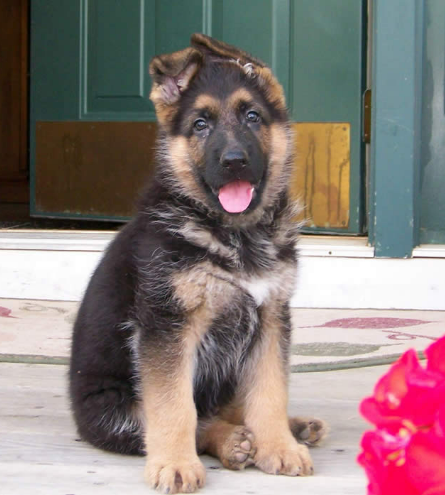
4.2.6. Scale (metric system)
4.2.7. Two blank guns (6 mm) with adequate blank ammunition
4.2.8. Numbered bibs or armbands for dog handlers
4.3. Duties of Breed Survey Secretary
4.3.1. Mail breed survey entry forms a minimum of three weeks in advance.
4.3.2. Check submitted documents for completeness and correctness, and check the eligibility of dogs for entering the breed survey.
4.3.3. Confirm that owners who are residents of the United States are USA members
4.3.4. Prepare Körlisten and temporary breed survey certificates and have them ready for the breed survey master either prior to or at the start of the survey. The forms are available from the USA Breed Book Office.
4.3.5. Inform the breed survey master regarding receipt and number of entries.
4.3.6. Provide a catalogue-like list of participants that is divided by males and females, and first and repeat breed surveys.
4.3.7. Submit the checked documents for each dog to the breed survey master before the start of the breed survey.
5. REGISTERING FOR THE SURVEY
The following documents must be submitted no later than the day of the breed survey:
5.1. Original USA-recognized pedigree showing proof of USA registration.
5.2. Original breed show rating book/card showing proof of breed show rating.
5.3. Original scorebook showing proof of AD, BH, and one performance title.
5.4. Original hip certificate showing proof of USA-recognized hip certification with tattoo number or microchip identification, if not entered on the pedigree.
5.5. Original breed survey report in cases of resurvey.
5.6. Original signature authorization form for dogs that are co-owned, unless previously submitted to the USA Breed Book Office (form available from the USA Breed Book Office).
5.7. Photocopy of USA membership card.
6. SURVEY PROCEDURE
6.1. Temperament Test
The breed survey master must subject each dog to a temperament test. Temperament evaluation may extend throughout the entire survey. According to the standard, the dog must display sound temperament; i.e., be carefree, self-confident, and good-natured and have steady nerves.
6.2. Gun Test
From a distance of at least 15 paces, at least two shots must be fired from a blank gun (6 mm). The dog must not have a negative reaction to the gunfire.
6.3 Protection Work Execution – Surprise Attack with Guarding
6.3.1. The handler reports to the breed survey master with the dog on leash.
6.3.2. Upon instruction by the breed survey master, the handler assumes the basic position at a marked spot 30 paces from the blind and takes the leash off the dog.
6.3.3. The leash must be placed around the shoulder or in the pocket of the handler.
6.3.4. Upon a signal from the breed survey master, the handler walks toward the blind with the free-heeling dog.
6.3.5. The dog must stay closely at heel.
6.3.6. Upon a signal from the breed survey master, the helper performs an attack while making threatening noises. The attack occurs when handler and dog are five paces away from the blind.
6.3.7. The dog must counter the attack immediately and confidently and must bite hard and full.
6.3.8. Once the dog has a grip on the sleeve, the helper applies two stick hits with a soft stick on either the thighs, the sides, or in the area of the withers.
6.3.9. The handler may verbally encourage the dog to counter the attack.
6.3.10. Upon a signal from the breed survey master, the helper stops the attack and stands still.
6.3.11. The dog must release either on its own or upon receiving the verbal command “aus/out” and must guard the helper.
6.3.12. The breed survey master gives the handler the instruction to step up to the dog.
6.3.13. The handler puts the dog on leash and receives the instruction from the breed survey master to step into the assigned blind.
6.4. Protection Work Execution – Attack, Fight, and Guarding
6.4.1. The breed survey master tells the handler to leave the assigned blind and take the position on the centerline.
6.4.2. The handler takes the dog off leash and holds the dog by the collar.
6.4.3. The dog must stay in this position until he is sent to counter the attack with the verbal command “voran/go on.”
6.4.4. Upon receiving a signal from the breed survey master, the helper leaves the assigned blind, which is located at a distance of approximately 70-80 paces from the handler, and walks across the field at a normal pace.
6.4.5. The handler verbally commands the helper to stop by shouting “stop/stand still.”
6.4.6. The helper ignores the command and performs a frontal attack on the handler and the dog.
6.4.7. Immediately after the attack begins, the breed survey master gives the handler the instruction to counter the attack/send the dog.
6.4.8. The handler immediately sends his dog with the verbal command “voran/go on” and stands still.
6.4.9. The dog must energetically counter the attack with drive and with a strong, full, sure, and calm grip.
6.4.10. Once the dog has a grip on the sleeve, and after a brief pressure phase, the helper stops the attack on a signal from the breed survey master. No stick hits are given.
6.4.11. Thereafter, the dog must release either on its own or upon receiving the verbal command “aus/out” and must guard the helper.
6.4.12. Upon a signal from the breed survey master, the handler walks directly to the dog at a normal pace and puts the dog on leash.
6.4.13. With the dog on leash, the handler reports to the breed survey master and then leaves the field.
6.5. Protection Work Scoring – Release
6.5.1. After the helper stops the attack, the dog must release on its own.
6.5.2. The handler may give the first “aus/out” command on his/her own after a reasonable time.
6.5.3. If the dog does not release after the first “aus/out” command, the breed survey master instructs the handler to give two more “aus/out” commands, if necessary.
6.5.4. When giving the “aus/out” command, the handler must stand still and may not influence the dog in any way.
6.5.5. If the dog’s name is used, it is counted as an “aus/out” command.
6.5.6. If the dog releases on its own when the handler approaches, it can still be counted as a release; however, the handler must be at least five paces from the dog at that time.
6.5.7. If the dog releases on its own or in response to the “aus/out” command after the attack and after the defense exercise; the rating “does release” is awarded.
6.5.8. If the dog does not release—even once—on its own or in response to the “aus/out” command after the attack or after the defense exercise, the dog receives the rating “does not release.”
6.5.9. The breed survey ratings themselves are not affected by this rating.
6.5.10. The breed survey master stays near the handler during the entire protection routine, and keenly observes the behavior of dog and handler until after the handler has picked up the dog.
6.6. Protection Work Scoring – Evaluation of Instinctive Behavior, Self-Confidence, and Ability to Cope with Stress (TSB)
6.6.1. The overall rating of the protection exercises is scored as “pronounced,” “present,” or “insufficient.”
6.6.2. Pronounced: Self-confident, intense, goal-oriented and secure gripping and holding, no negative reactions to the stick hits, and close and attentive watching in the guarding phases.
6.6.3. Present: Deficiencies, for example, in self-confidence, in goal-oriented behavior, in grip and stick behavior, as well as in the guarding phases.
6.6.4. Insufficient: Lacking self-confidence, strong deficiencies with respect to hardness, and disinterest in the helper.
6.7. Measurements and Weights
The breed survey secretary or an assistant may weigh the dogs and take measurements for chest depth and chest circumference. The breed survey master must take measurements of the height at the withers.
6.8. Examination of Standing Dog and Evaluation of Movement
During this examination, the breed survey master writes the breed survey report. The handler must refrain as much as possible from influencing the dog during this examination.
6.9. Reports and Certificates
After completing the survey for each dog, the breed survey master announces the results over the loudspeaker. The owners of the dogs receive a temporary breed survey certificate signed by the breed survey master that shows the survey result. This certificate is proof of breed survey and replaces the original paperwork while the USA Breed Book Office is processing the breed survey.
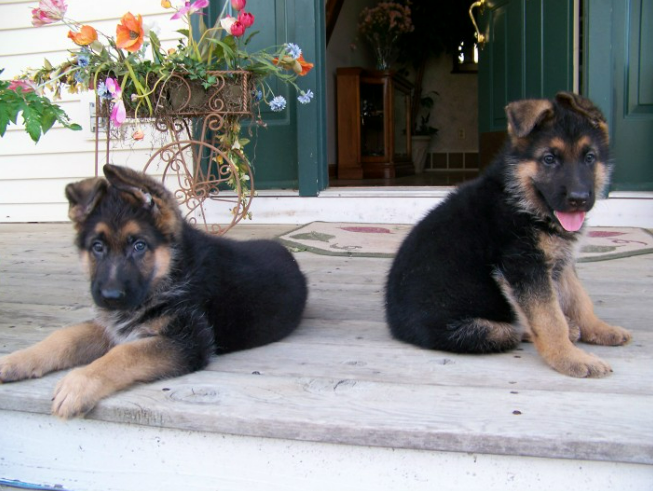
7. BREED SURVEY
7.1. Survey Class 1
Survey Class 1 is the highest breed survey classification and is awarded to dogs recommended for breeding. This class is limited to dogs that conform to the breed characteristics as follows:
7.1.1. Measurements, weight, and structure conform to the standard.
7.1.2. Overall temperament is self-confident and good-natured, with TSB rating of “pronounced.”
7.1.3. Faultless dentition with no missing teeth; however, double premolars #1 are allowed.
7.2. Survey Class 2
Survey Class 2 is the lower breed survey classification and is awarded to dogs approved for breeding. This class includes dogs with the following faults:
7.2.1. Minor anatomical faults.
7.2.2. Oversized or undersized up to 1 cm, measured at the withers (maximum is males 66 cm/ bitches 61 cm and minimum is males 59 cm/bitches 54 cm).
7.2.3. TSB rating of “present.”
7.2.4. Dentition faults as follows:
? Missing one premolar #1 or one incisor
?nbsp;Missing two premolars #1
?nbsp;Missing one premolar #1 and one incisor
?nbsp;Missing one premolar #2
?nbsp;Slight level bite of the middle incisors
7.3. Upgrading of Survey Class
The owner of a dog surveyed in Class 2 (initial or repeat survey) has the option of presenting the dog again for a breed survey improvement in the first year of the current breed survey. Application for survey rating upgrade is possible one time for both the initial survey and resurvey.
7.4. One-Year Deferment
A one-year deferment is possible for the following reasons:
7.4.1. The physical development of the dog is not advanced enough for surveying, but the dog is expected to reach desirable development.
7.4.2. The TSB evaluation of the dog is insufficient to pass the breed survey.
7.4.3. A one-year deferment is only possible one time for the same reason.
If the dog fails a second time for the same reason, the dog is not suitable for surveying.
7.5. Not Suitable for Survey
The following faults preclude a breed survey:
7.5.1. Considerable anatomical faults.
7.5.2. Oversized or undersized more than 1 cm, measured at the withers (maximum is males 66 cm/ bitches 61 cm and minimum is males 59 cm/bitches 54 cm).
7.5.3. Testicle faults.
7.5.4. Dentition faults as follows:
?nbsp; Missing one premolar #3
?nbsp; Missing two incisors
?nbsp; Missing one premolar #2 plus one incisor
?nbsp; Missing one premolar #2 plus one premolar #1
?nbsp; Missing two premolar #2
7.5.5. Considerable pigment deficiencies.
7.5.6. Long coat or long stock coat.
7.6. Survey Term
7.6.1. The term for initial survey and survey after lapse is two years. The dog must be presented again during the second year of the current breed survey for the resurvey for life.
7.6.2. Resurvey is effective for life.
7.6.3. Upgrading of survey class does not extend the original survey term.
7.6.4. The survey term for females that are in an advanced stage of pregnancy or are nursing may be extended for an additional year without the female being presented for evaluation (survey extension). Survey extension is not possible for any other reasons and may be granted one time. On the day of the breed survey the following proof must be presented:
• Pregnancy of at least 42 days by submission of the stud certificate/report of breeding card.
• Certificate issued by the local breed warden or a licensed veterinarian verifying that the female is visibly pregnant.
• Certificate issued by the local breed warden or a licensed veterinarian verifying that the female is nursing if no more than 42 days have elapsed from the whelping day to the survey day.
7.7. Termination of Survey Status
7.7.1. If a surveyed dog is not presented for resurvey, the breed survey status expires at the end of the calendar year.
7.7.2. Breed survey status is terminated by “breed survey status repeal.” Breed survey status is repealed upon application of the breed survey master or breed judge directed to the USA Breed Book Office. Breed survey status may be suspended during the time the application is being processed.
8. BREED SURVEY CERTIFICATE AND BREED SURVEY BOOK
The USA Breed Book Office returns to the owner in a timely manner the original documents submitted at the breed survey. Upon processing of the breed survey, the breed survey results will be published in the next possible issue of the USA magazine. The owner receives a translation of the breed survey report from the USA Breed Book Office. The breed survey result is noted on the original pedigree.
Data on dogs surveyed during each year are published, separated by gender, in the USA Breed Survey Book. The Breed Survey Book contains comprehensive information for the dogs recommended or suitable for breeding, including physical characteristics and temperament. Together with the comments of the breed survey master with respect to breeding recommendations, this information makes this book a comprehensive and indispensable reference source for the serious breeder.
What is Schutzhund?
Schutzhund is a German word meaning “protection dog.” It refers to a sport that focuses on developing and evaluating those traits in dogs that make them more useful and happier companions to their owners.
Schutzhund work concentrates on three parts. Many familiar with the obedience work of the American Kennel Club’s affiliates will recognize the first two parts, tracking and obedience. The Schutzhund standards for the third part, protection work, are similar to those for dogs in police work.
While dogs of other breeds are also admitted to Schutzhund trials, this breed evaluation test was developed specifically for the German Shepherd Dog. Schutzhund is intended to demonstrate the dog’s intelligence and utility. As a working trial, Schutzhund measures the dog’s mental stability, endurance, structural efficiencies, ability to scent, willingness to work, courage and trainability.
This working dog sport offers an opportunity for dog owners to train their dog and compete with each other for recognition of both the handler’s ability to train and the dog’s ability to perform as required. It is a sport enjoyed by persons of varied professions, who join together in a camaraderie born of their common interest in working with their dogs. Persons of all ages and conditions of life — even those with significant disabilities — enjoy Schutzhund as a sport. Often, it is a family sport.
Schutzhund Titles
In addition to the Schutzhund titles, the GSDCA-WDA offers three additional training degrees. Two of these, the FH1 and FH2, are advanced tracking degrees that require the dog to follow tracks over changing terrain, discriminate between cross-tracks and is at least 3 hours old.
The third is the BH. The BH is a degree for traffic-safe companion dogs that tests the dogs temperament in and around people. It includes basic formal obedience – heeling on and off leash, sits, downs and recalls – as well as practical tests of the dog’s character in everyday situations. These include reaction to normal situations involving crowds of people, strange noises, joggers, cars and other dogs. Before being allowed to enter for a Schutzhund I title, the dog must first have successfully completed the BH.
There are three levels of the Schutzhund test for which titles can be earned.
For Schutzhund I the dog must be at least 18 months old and pass an initial temperament test by the judge. The dog must heel on the leash and off, demonstrate the walking sit, the walking down, and the stay tests, as well as, the send-out. It must retrieve on the flat and over a hurdle. In tracking, it must be able to follow a track laid by its handler at least 20 minutes earlier. There are also protection tests.
For Schutzhund 2 the dog must be at least 19 months old and must already have earned its Schutzhund I degree. It must again pass all of the obedience and protection tests required for the Schutzhund I degree, but those tests, for Schutzhund 2, are made more difficult and require greater endurance, agility, and above all, control. There is an additional retrieve required over the six foot slanted wall. In tracking, the Schutzhund 2 candidate must be able to follow a track laid by a stranger at least 30 minutes earlier.
For Schutzhund 3 the master’s degree, the dog must be at least 20 months old and must have earned both the Schutzhund I and the Schutzhund II titles. Again, the tests now are made far more difficult. All exercises in obedience and protection are demonstrated off leash. There is the additional of a walking and running stand. In tracking, the dog must follow a track that was laid by a stranger at least 60 minutes earlier. The track has four turns, compared with two turns for Schutzhund I and 2, and there are three objects, rather than two, that must be found by the dog. The picture of obedience, strength, eagerness and confidence presented by an excellent Schutzhund 3 team is a beautifully illustration of the partnership of human and dog.

